
USS Raleigh (LPD-1), the lead ship of her class of amphibious transport docks, was the fourth ship of the United States Navy named for the capital of North Carolina, which in turn honors the English explorer Sir Walter Raleigh, the first to attempt the establishment of an English settlement in the United States of America.

USS Trenton (LPD-14), an Austin-class amphibious transport dock, was the third ship of the United States Navy to be named for the capital of New Jersey. In 2007, it was sold to the Indian Navy and renamed INS Jalashwa.

USS Shreveport (LPD-12) is an Austin-class amphibious transport dock. It is the second ship of the United States Navy to be named for the city in Louisiana. Her keel was laid down on 27 December 1965 by the Lockheed Shipbuilding and Construction Company of Seattle, Washington. She was launched on 22 October 1966 sponsored by Mrs. Andrew McBurney Jackson, Jr., and commissioned on 12 December 1970.
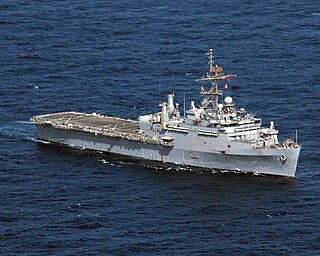
USS Nashville (LPD-13), an Austin-class amphibious transport dock, was the third ship of the United States Navy to be named for the capital city of Tennessee. Her keel was laid down on 14 March 1966 by the Lockheed Shipbuilding and Construction Company of Seattle, Washington. She was launched on 7 October 1967 sponsored by Mrs. Roy L. Johnson, and commissioned at Puget Sound Naval Shipyard, Bremerton, Washington, on 14 February 1970.

USS Peterson (DD-969), named for Lieutenant Commander Carl Jerrold Peterson (1936–1969), was a Spruance-class destroyer laid down by the Ingalls Shipbuilding Division of Litton Industries at Pascagoula, Mississippi. Peterson was sponsored by Mrs. Miriam C. Peterson, the mother of LCDR Carl J. Peterson. Matron of Honor was Peterson's sister, Mrs. John F. Elliott. She was commissioned on 9 July 1977 and decommissioned on 4 October 2002.

USS Iwo Jima (LPH-2) was the lead ship of her class and type and the first amphibious assault ship to be designed and built from the keel up as a dedicated helicopter carrier. She carried helicopters and typically embarked USMC elements of a Marine Amphibious Unit (MAU)/later Marine Expeditionary Unit (MEU) principally the Aviation Combat Element (ACE) to conduct heliborne operations in support of an amphibious operation. There was no well deck to support landing craft movement of personnel or equipment to/from shore. Iwo Jima was the second of three ships of the United States Navy to be named for the Battle of Iwo Jima, although the first to be completed and see service.

USS Okinawa (LPH–3) was the second Iwo Jima-class amphibious assault ship of the United States Navy. She was the second Navy ship assigned the name "Okinawa", in honor of the World War II Battle of Okinawa.

USS Guadalcanal (LPH-7), the third Iwo Jima-class amphibious assault ship (helicopter), was launched by the Philadelphia Naval Shipyard 16 March 1963, sponsored by Zola Shoup, wife of General Shoup, the former Commandant of the Marine Corps; and commissioned 20 July 1963. It was the second ship in the Navy to bear the name.

USS Guam (LPH-9), was an Iwo Jima-class amphibious assault ship, and was laid down by the Philadelphia Naval Shipyard on 15 November 1962; launched on 22 August 1964, sponsored by Mrs. Vaughn H. Emory Green, and commissioned on 16 January 1965. She was the third US Navy ship to carry the name, after the US Territory of Guam.
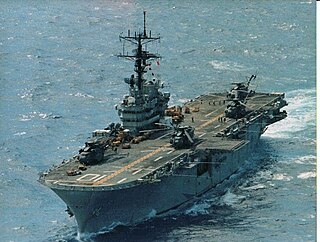
USS Tripoli (LPH-10), an Iwo Jima-class amphibious assault ship, was laid down on 15 June 1964 at Pascagoula, Mississippi, by the Ingalls Shipbuilding Corporation; launched on 31 July 1965; sponsored by Jane Cates, the wife of General Clifton B. Cates, former Commandant of the Marine Corps; and commissioned on 6 August 1966 at the Philadelphia Naval Shipyard. Tripoli was the second US Navy ship named for the Battle of Derna in 1805. It was the decisive victory of a mercenary army led by a detachment of US Marines and US Army soldiers against the forces of Tripoli during the First Barbary War. It was the first recorded land battle of the United States fought overseas.

USS New Orleans (LPH-11) was an Iwo Jima-class amphibious assault ship in the United States Navy. She was the third Navy ship to be so named, and is the first named for the Battle of New Orleans, which was the last major battle of the War of 1812.

The Iwo Jima-class amphibious assault ships of the United States Navy were the first amphibious assault ships designed and built as dedicated helicopter carriers, capable of operating up to 20 helicopters to carry up to 1,800 marines ashore. They were named for battles featuring the United States Marine Corps, starting with the Battle of Iwo Jima. The first ship of the class was commissioned in 1961, and the last was decommissioned in 2002. The hull classification of "LPH" stands for "Landing Platform Helicopter".

USS John Rodgers (DD-983), a Spruance-class destroyer, was the sixth ship of the United States Navy to be named for the three generations of the Rodgers family who served in the navy.
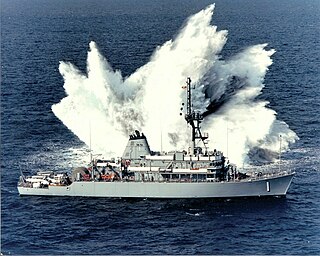
USS Avenger (MCM-1) was the lead ship of her class of mine countermeasures ship, and the third U.S. Navy ship of that name.

USS Sylvania (AFS-2), a Mars-class combat stores ship, was the second ship of the United States Navy to be named Sylvania.
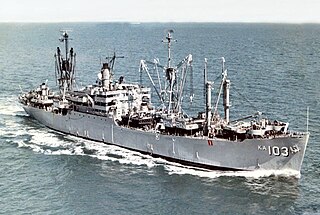
USS Rankin (AKA-103/LKA-103) was a Tolland-class attack cargo ship in service with the United States Navy from 1945 to 1947 and again from 1952 to 1971. She was finally sunk as an artificial reef in 1988.

USS Adroit (AM-509/MSO-509) was an Acme-class minesweeper acquired by the U.S. Navy for the task of removing mines that had been placed in the water to prevent the safe passage of ships.

USS Mount Vernon (LSD-39) was an Anchorage-class dock landing ship of the United States Navy. She was the fifth ship of the U.S. Navy to bear the name. She was built in Massachusetts in 1972 and homeported in Southern California for 31 years until being decommissioned on 25 July 2003. Mount Vernon acted as the control ship for the cleanup of the Exxon Valdez oil spill. In 2005, she was intentionally destroyed off the coast of Hawaii as part of a training exercise. USS Mount Vernon also appeared in the Season 7 episode 19 of The Love Boat when they visited Hong Kong.
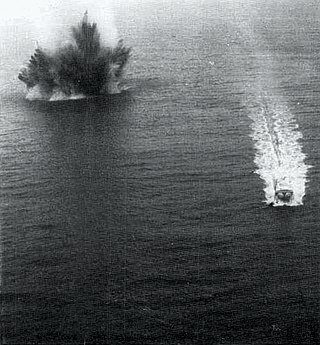
Operation End Sweep was a United States Navy and United States Marine Corps operation to remove naval mines from Haiphong harbor and other coastal and inland waterways in North Vietnam between February and July 1973. The operation fulfilled an American obligation under the Paris Peace Accord of January 1973, which ended direct American participation in the Vietnam War. It also was the first operational deployment of a U.S. Navy air mine countermeasures capability.

Expeditionary Strike Group SEVEN/Task Force 76 is a United States Navy task force. It is part of the United States Seventh Fleet and the USN's only permanently forward-deployed expeditionary strike group. It is based at the White Beach Naval Facility at the end of the Katsuren Peninsula in Uruma City, Okinawa, Japan.































